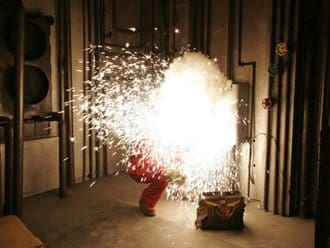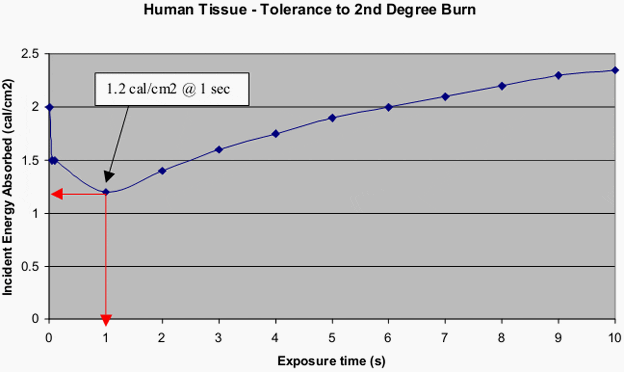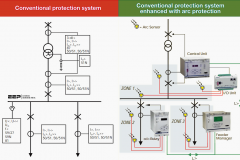
Incident energy is the energy per unit area received on a surface located a working distance away from the arc flash location. The working distance is the distance from where the worker to the flash location. This is basically an arm length away or approximately 18 inches for low voltage panelboards, smaller equipment, and 24 inches for Switchgear. The distance is longer as the voltage increases.
The unit of incident energy is cal/cm2. The threshold value of incident energy for 2nd degree burn of the human skin is about 1.2 cal/cm2. One cal/cm2 is equivalent to the amount of energy produced by a cigarette lighter in one second. It is the incident energy that causes burns to the human skin. Table 1 illustrates the potential damage of incident energy.
Table 1: Incident Energy & Damage Level
| Incident Energy (cal/cm2) | Degree burn |
| 1.2 | 2nd degree burn to bare skin |
| 4 | Ignite a cotton shirt |
| 8 | 3rd degree burn to bare skin |
Incident energy is both radiant and convective. It is inversely proportional to the working distance squared. It is directly proportional to the time duration of the arc and to the available bolted fault current. It should be noted that time has a greater effect on the incident energy than the available bolted fault current.

Both the NFPA-70E and IEEE Standard 1584 uses the assumption that an arc flash generating 1.2 calorie/cm2 (1.2 calorie/cm2 = 5.02 Joules/cm2 = 5.02 Watt-sec/cm2) for 0.1 second will result in a second-degree burn. It is also assumed that a second-degree burn will be curable and will not result in death.
Figure 1 above illustrates these points.
Arc Flash PPE Laboratory Testing Video
Reference: Arc Flash Hazard – The Basics by Robert E. Fuhr, P.E. Senior Member IEEE, Viet Tran, IEEE, and Tam Tran, IEEE











Hi,
Wondering if the figure 1 table is in error?
Reference is made to the below chart.
https://arcadvisor.com/images/articles/Stoll-curve.jpg
I have not seen any assumption in NFPA 70E and IEEE Standard 1584 that an arc flash generating 1.2 calorie/cm2 for 0.1 second will result in a second-degree burn. The problem is the NFPA 70E measures arc hazard in cal/cm2 units without any regard to how fast the energy was delivered. As an example, 1.2 cal/cm2 delivered in one (1) second is just enough to cause 2nd degree burn. Only a fraction of 1.2 cal/cm2 is actually required to inflict second degree burn during bare skin exposure to heat when the heat is delivered at a rate higher than 1.2 cal/cm2 per second. The same 1.2 cal/cm2 delivered in 10 seconds will cause no damage at all. Read http://arcadvisor.com/faq/threshold-incident-energy-second-degree-burn for more information.
todo es excelente. me gustaría participar con temas de ingeniería…saludos…